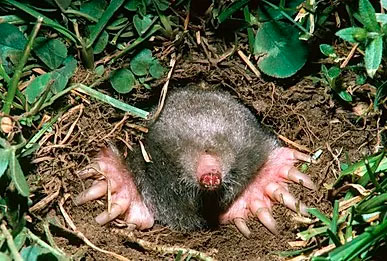Each Spring we receive quite a few calls regarding Moles and Voles. Though they sound similar, these animals are quite different in most respects, and require different control strategies.

Moles are commonly referred to as rodents, when in actuality they are highly socialized subterranean mammals. They belong to a class called Insectivora whose members feed on insects. As a Mole tunnels along it will push soils toward the surface leaving telltale ridges and piles. It can be said that they are beneficial, as grubs and beetles are a part of their diet. However, they can be quite destructive while in search of the ever-present earthworm, which is their main staple.
Moles do not hibernate, and are most active in the early spring, especially after a rain when soils are moist. Vegetation is rarely a part of their diet. Damage to plant material is usually limited to physical disruption from tunneling. If plants are being consumed, it is more likely that mice are using the Mole’s tunnels, or Voles have infested that area.
Because its’ habitat is underground, control can be difficult. Applying a grub control each year limits that availability of this food source, but since they feed on a wide range of insects, it cannot provide complete control. For those of us who don’t have an outdoor cat, trapping is the best form of control.
A mole has several tunnels. The main runway is used regularly as a thoroughfare for access to feeding tunnels, and is about 10″ underground. After a rain it uses/creates the shallower feeder tunnels to search for food. Moles are notorious for their inability to tolerate their own kind, and one animal usually causes all the damage.
Specialized Mole traps and baits are carried by local garden and hardware stores, and usually come with a good set of instructions. Proper location is the key to successful control. Set traps in the main runway or active feeder tunnels. The main runway may be found by pushing a rod into the soil, and noting the change in resistance as it reaches the tunnel. Active feeder tunnels can be detected by compressing an area of tunnels and checking daily to see which ones have been re-excavated.
Zinc phosphide is the most effective bait control. Baits are sensitive to moisture and are less effective than traps. If baits are used, cover the access hole with a shingle to help prevent excess moisture from contaminating the mixture. Moles have an excellent sense of smell. Wearing rubber gloves while handling both traps and baits will prevent the human scent from adhering to them, allowing for greater success.
One last thing: If you are adverse to the trapping of these “furry friends”, learn to live with their damage. Most problems occur in the early spring. Once done, you can rake and re-seed with a fair degree of certainty that you’ll not have to repeat the measure until the following year.

Voles are a close relative of mice, and are actually called field mice in many locations. Voles are rodents that feed on plant material. They are a primary pest of apple orchards, and can have an equally negative impact on landscape plantings. Voles are very prolific. A single Vole may rear up to 80 offspring in one year. Unlike the mole, several voles will inhabit a single area, requiring repetitive trapping to alleviate an infestation.
Vole activity is most evident during the dormant season when other food sources are less plentiful. Voles will eat the green inner bark layer of trees and shrubs, girdling and eventually killing the plant. They also eat leaves, shoots, roots, tubers, and seeds. Voles can damage lawns by constructing runways and trimming the grass to its roots. Lawn damage is usually not permanent, but temporarily detracts from its appearance.
Trapping, baiting, or exclusion are effective vole controls. If your goal is to protect a prize tree or two, exclusion is the way to go. Place a cylinder of hardware cloth around their trunks. The cylinder should be tight to the ground or buried a few inches. Cylinders will last for up to five years, so allow plenty of room for trunk expansion.
For a more severe Vole infestation, trapping or baiting provide an effective solution. Since Vole activity is at or very near the soil surface, trapping is fairly easy. Place standard snap type mousetraps within the runway system. A single trap perpendicular to the runway or two traps back to back will do the trick. For best results set the traps in two or three locations. Bait with a mixture of oats and peanut butter, or apple slices, and check and reset traps daily until full control is achieved. Baiting with Zinc phosphide is also an effective control. Place the bait in the runway and cover with a shingle to prevent excess moisture from ruining the bait.
Written By: Terence Boots
Massachusetts Certified Arborist
Owner: Emerald Acres Inc.
